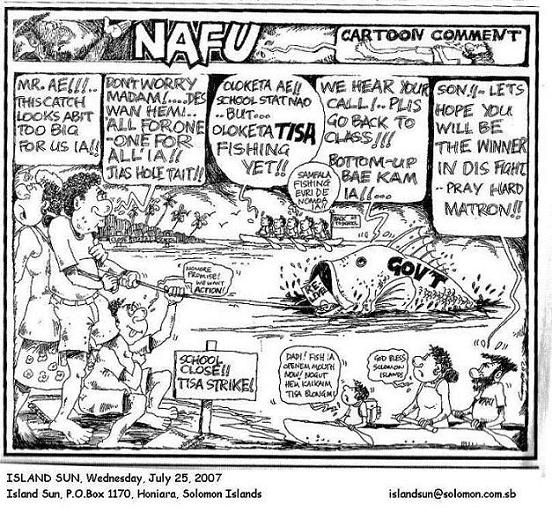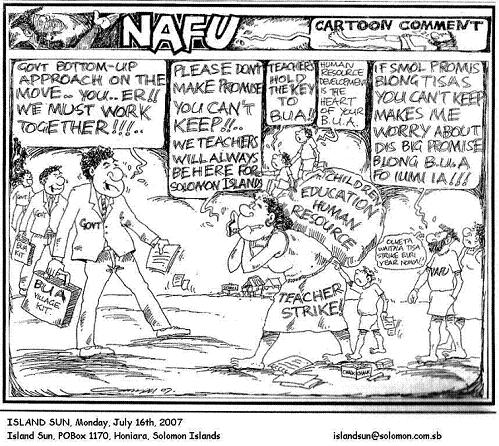Solomon Islands Labour Movement
Contents
200 years of Labour Movement in the Solomon Islands
1780s – 1930s Colonisation, land alienation and indentured slave labour.
1786 - 1868 Transportation of around 160,000 English prisoners to Australia. European companies mostly concerned with whaling and fishing. Islanders begin to trade using food and prostitution.
1870 - 1907 Around 20,000 Solomon Island labourers transported to Queensland in Australia as indentured labour for the sugar industry.
1890 - 1914 Alienation of large areas of land for coconut plantations.
1868 Queensland government passes the Polynesian Labourers Act to control movement of workers. 1871 The Carl, a ‘blackdirding’ ship kidnaps 85 from northern Solomon islands, who are shot and thrown overboard. These who survive are sold as slaves in Fiji. 1872 Pacific Islanders Protection Act (AKA the Kidnapping Act) gives licences to labour traders. 1874 Britain annexes Fiji 1893 British Solomon Islands Protectorate declared
1901 Commonwealth of Australia founded. Start of ‘White Australia’ policy. Pacific Islands Labourers Act orders deportation of islander labourers. 3000 protest including the Aborigines Protection Society.
1930s Depression and fall in Copra prices leads to reduction in indentured labour by the big European companies, Burns Philp, Solomon Islands Development Company, Levers.
1940s - 50s Maasina Ruru movement
1943 Nori, Noonomai and Fiifii’I meet while serving in the Solomon Islands Labour Corps in World War 2, while SI is occupied by Japan then USA. They organize autonomous production and lobby government against racist treatment of workers, by refusing to pay taxes and withdrawing labour. Over 2000 members arrested, including leadership. 1953 Maasina Ruru disbands after the formation of the regional councils, including the Malaita Native Council and Marau Hauba Council which soon after dissolves into the Guadalcanal Council.
1958 Cocoa plantations started 1960s Large scale Logging started 1970s Oil palm plantations started
1960s - 90s SI Trade Union movement
1960 SI Civil Servants Association (SICSA) with over 300 members write to UK newspapers to raise standards for workers 1961 The first SI union Solomon Islands Workers Union (SIWU) organizes port and plantation workers 1962 SIWU organises a strike for 1,100 builders and construction workers. 1963 SIWU is split by the government Labour Department into BSI Ports and Copra Workers Union and the BSI Building and General Workers Union 1965 Building workers make a deal for government labourers but is rejected and 800 strike and demonstrate in Honiara. The strike is attacked by the police using tear gas.
1969 Labour and Trade Union Ordinances amended: Commissioner of Labour appointed, regulation of hours, wages, contract, minimum wage set.
1976 Public service commission setup, its power is rivalled by the SI Public Employees Union (SIPEU), SI National Teachers Association (SINTA) and their unions.
1976 Bart Ulufa’alu leader of SIGWU is elected to parliament.
1977 The Registrar of TUs suspends SIGWU
1978 SI Independence
1980 Solomon Islands General Workers Union is renamed Solomon Islands National Union of Workers
1981 Trade dispute act and trade dispute panel is setup
1986 SI Council of Trade Unions (SICTU) representing over 90% of SI trade unions is formed
1987 Labour Party formed by SICTU
1990 Protests against land alienation lead to the overthrow of the SI government
2003 RAMSI Intervention
2007 Empowerment of the Chiefs
Questions
- What is the difference between the following:
- 'transportation'
- 'slavery'
- 'indentured labour' ?
- List 3 differences and 3 similarities between
- Maasina Ruru and
- a Trade Union?
- What do the following stand for?
- SIGWU?
- SINTA?

